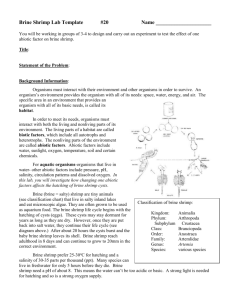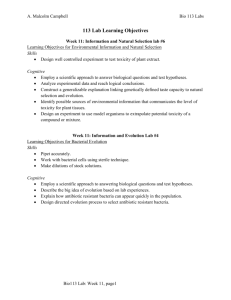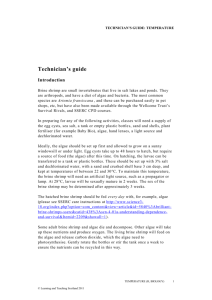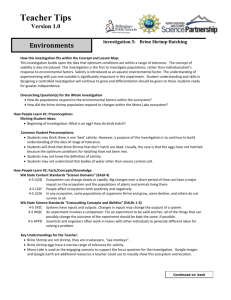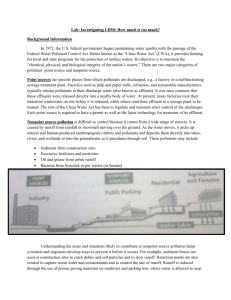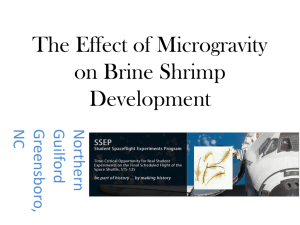Brine Shrimp Hatching Experiment Summary Objectives Materials
advertisement
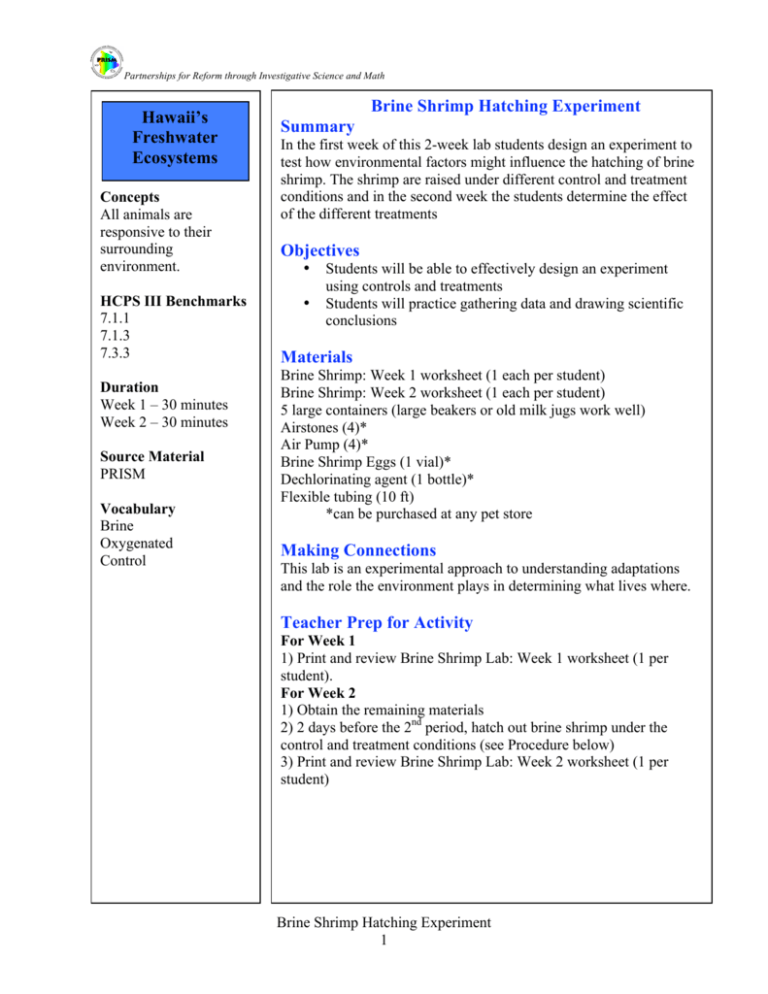
Partnerships for Reform through Investigative Science and Math Hawaii’s Freshwater Ecosystems Concepts All animals are responsive to their surrounding environment. HCPS III Benchmarks 7.1.1 7.1.3 7.3.3 Duration Week 1 – 30 minutes Week 2 – 30 minutes Source Material PRISM Vocabulary Brine Oxygenated Control Brine Shrimp Hatching Experiment Summary In the first week of this 2-week lab students design an experiment to test how environmental factors might influence the hatching of brine shrimp. The shrimp are raised under different control and treatment conditions and in the second week the students determine the effect of the different treatments Objectives • • Students will be able to effectively design an experiment using controls and treatments Students will practice gathering data and drawing scientific conclusions Materials Brine Shrimp: Week 1 worksheet (1 each per student) Brine Shrimp: Week 2 worksheet (1 each per student) 5 large containers (large beakers or old milk jugs work well) Airstones (4)* Air Pump (4)* Brine Shrimp Eggs (1 vial)* Dechlorinating agent (1 bottle)* Flexible tubing (10 ft) *can be purchased at any pet store Making Connections This lab is an experimental approach to understanding adaptations and the role the environment plays in determining what lives where. Teacher Prep for Activity For Week 1 1) Print and review Brine Shrimp Lab: Week 1 worksheet (1 per student). For Week 2 1) Obtain the remaining materials 2) 2 days before the 2nd period, hatch out brine shrimp under the control and treatment conditions (see Procedure below) 3) Print and review Brine Shrimp Lab: Week 2 worksheet (1 per student) Brine Shrimp Hatching Experiment 1 Partnerships for Reform through Investigative Science and Math Background Native to extremely salty water such as the Great Salt Lake and the salt flats surrounding the San Francisco Bay, brine shrimp have become very popular in the aquarium industry as feed for small or juvenile fish. While these shrimp are not found in Hawaii and are not even a freshwater species, they are cheap, accessible, and very easy to hatch, which makes them an excellent choice for working with in the classroom. Moreover, most Hawaiian freshwater species are hard to find and take a long time to hatch from eggs and to mature into adults. For example, the native Hihiwai snail takes about 1 year to mature into an adult. Even the invasive Pouch Snail, we learned, takes longer than 6 weeks to start reproducing. Brine shrimp, on the other hand, can be bought at any pet store, will hatch within 24 hours, and become mature in about a week. Because of these qualities, working with brine shrimp can help us learn how to design a good experiment, which is the focus of this lab. Week 1 of this lab is designed to train students to try to find their own answers. To do this, they are given a page of information about brine shrimp and experimental design, then—on their own and based on this reading—they must combine the two to design a simple experiment to look at the effect of 1 of 4 environmental variable (water temperature, salinity, light, and oxygen) on the hatching of brine shrimp. In Week 2 they will conduct this experiment. Vocabulary Brine: water with more salt in it than ocean water. Control: in an experiment it is often useful to compare treatments (introduced in the Build an Island activity) not only against each other, but against normal or unaltered conditions, which are known as a control. Oxygenated: Aquatic animals take in oxygen from the surrounding water, usually through gills. However, oxygen levels can vary dramatically and water that is not well mixed may have very low oxygen levels. This is especially common in low flow areas such as taro fields Procedure Week 1 1) Hand out Brine Shrimp Week 1 worksheet and give students approximately 15 minutes to read through the first page and answer questions 1-4 on the back. 2) While they are doing this, copy this chart onto the board: Beaker # Temperature Salinity Light 1 Warm High Light 2 Cold High Light 3 Warm Low Light 4 Warm High Dark 5 Warm High Light Oxygenated Yes Yes Yes Yes No 3) When the students have finished, discuss the answers as a class. Some important questions are: 1- Which is the control beaker and why? - the one that has the natural conditions for the shrimp (beaker 1). Brine Shrimp Hatching Experiment 2 Partnerships for Reform through Investigative Science and Math 2- What is the treatment beaker for each variable? (go through them all ) - general answer: the one that differs from the control beaker in only that variable. 3- Why can’t we compare, for example, beakers 2 and 3? - we wouldn’t be able to identify which variable is producing any observed effect 4- What else could we measure besides the number of hatchlings (answer to Q 4)? - growth rate, survivorship (put adults into different treatments), reproduction… Prior to Week 2 2 days prior to the second period, hatch out the brine shrimp under the 5 different conditions. The brine shrimp eggs will come with detailed hatching instructions that will call for warm water, salt, some light, and oxygen from an air stone. This can then be modified for each treatment. Temperature: add ice cubes to maintain colder water temperature. Also add extra salt to compensate for the fresh water from the melted ice cubes Salinity: use fresh water Light: cover container with a piece of cloth Oxygen: do not use airstone and avoid excessive mixing The general protocol is: 1) Fill containers with water - a half gallon is a good volume for hatching and will produce thousands of brine shrimp under optimal conditions 2) Add appropriate amount of dechlorinating agent and salt and mix - at the stage the amount of added oxygen from the mixing is unnecessary. 3) Add appropriate amount of brine shrimp eggs and let stand for about an hour 4) Connect airstone to pump and place in container. Place so as to prevent excessive settling of the eggs on the bottom of the container. Brine shrimp are extremely forgiving and will hatch under a wide range of conditions. However they are also responsive to environmental conditions and so long as there is a difference between each treatments (the cold water is colder than the others, for example), there will likely be a clear and corresponding difference in the number of hatchlings. Week 2 1) Set up labeled treatment beakers around classroom. 2) Hand out Brine Shrimp Lab: Week 2 worksheets and release the students to complete questions 1-3. 3) Discuss results as a class. 4) Give them about 10 more minutes to complete questions 4-8 Assessments Completion of the handouts Brine Shrimp Hatching Experiment 3 Partnerships for Reform through Investigative Science and Math Extension Activities This lab can easily be extended into a small report where the students identify the initial question, hypothesis, experimental design, results, and conclusion of this experiment. Additionally, other potential treatments include the presence of pollutants such as chlorine (tap water without dechlorinating agent). Brine Shrimp Hatching Experiment 4 Partnerships for Reform through Investigative Science and Math Brine Shrimp Hatching Experiment – Week 1 Name: Date Period: Brine Shrimp (Artemia franciscana) are small shrimp that live in extremely salty water such as The Great Salt Lake in Utah. Because they live in salty water, these shrimp are not considered aquatic species (remember that aquatic = freshwater). They also do not live anywhere in Hawaii. However, most Hawaiian freshwater species are hard to find and take a long time to hatch from eggs and to mature into adults. For example, the native Hihiwai snail takes about 1 year to mature into an adult. Even the invasive Pouch Snail, we learned, takes longer than 6 weeks to start reproducing. Brine Shrimp, on the other hand, can be bought at any pet store, will hatch within 24 hours, and become mature in about a week. Because of these qualities, working with Brine Shrimp can help us learn how to design a good experiment. This week you will design an experiment that will tell you something about how environmental variables affect the hatching of Brine Shrimp. For example, do these shrimp need light or can they also hatch in the dark? Do they need warm water or can they also hatch in cold water? Can they hatch in tap water where chlorine has been added to kill everything? Is the saltiness of the water important? Is oxygen in the water important? If you design your experiment carefully you will be able to answer one of these questions by counting the number of shrimp that hatched under different conditions. Listed below are the variables that we will be looking at as a class. Each of you will be focusing on one of these variables. Water temperature Salinity (saltiness) Light Oxygenation When we design an experiment we want to think about comparing a Control group and a Treatment group. The control is what might be called the normal conditions and the treatment is what we changed to test the variable we want to study. For example, if we want to test the affect of salinity on hatching, we would compare how brine shrimp hatch under normal conditions, which in high salinity (very salty) water, with how they hatch low salinity (fresh) water. In this case the control is the salty water and the treatment is the fresh water. In this experiment we want everything else to be the same between the control and the treatment groups except for the one variable that we want to study. Brine Shrimp Hatching Experiment 5 Partnerships for Reform through Investigative Science and Math The normal conditions for Brine Shrimp are warm water, high salinity, light, and oxygenated water. Beaker # 1 2 3 4 5 Temperature Warm Cold Warm Warm Warm Salinity High High Low High High Light Light Light Light Dark Light Oxygenated Yes Yes Yes Yes No 1) Pick a variable you would like to study by filling in the blank in the sentence below. I will be studying the effect of _____________ on the hatching of brine shrimp. 2) What is the control beaker you will use to study this variable? Beaker Number ___________ 3) What is the treatment beaker you will use to study this variable? Beaker Number ___________ 4) What are you going to measure that will tell you if the variable you are studying has an effect on the hatching of Brine Shrimp? 5) Now that you know how to design an experiment using Brine Shrimp, what is a similar experiment that you could do with one of the species we’ve been studying? Identify an freshwater species that can be found in Hawaii and briefly describe an experiment that you could perform that would tell you something about the animal. Include the variable you would test and what you would measure in response. Brine Shrimp Hatching Experiment 6 Partnerships for Reform through Investigative Science and Math Brine Shrimp Hatching Experiment – Week 2 Name: Date: Period: Last week we designed an experiment to look at the variables that influence the hatching of Brine Shrimp. This week we will conduct this experiment. Brine shrimp have been raised under the following conditions to test the effects of Temperature, Salinity (Saltiness), Light, and Oxygen on hatching. Below are the conditions. Beaker # 1 2 3 4 5 Temperature Warm Cold Warm Warm Warm Salinity High High Low High High Light Light Light Light Dark Light Oxygenated Yes Yes Yes Yes No 1) Think back to last week and fill in the following blanks. I will be studying the effect of _______________ on the hatching of brine shrimp by comparing how many brine shrimp ________________ in beaker number _________ versus beaker number _________. 2) Are there more brine shrimp in the control or the treatment beaker? Circle the beaker that has the most shrimp. Treatment Beaker Control Beaker 3) Describe the difference between the two beakers. Are there a lot of hatched brine shrimp in one and only a few in the other? Do both even have hatchlings in them? What does the water look like in each? Is it clear? Is it murky? Brine Shrimp Hatching Experiment 7 Partnerships for Reform through Investigative Science and Math Use the class data to answer the following questions. 4) Is the water temperature important for the hatching of brine shrimp? How? 5) Is the salinity important for the hatching of brine shrimp? How? 6) Is light important for the hatching of brine shrimp? How? 7) Is oxygenation important for the hatching of brine shrimp? How? 8) The native ‘opae kala’ole is a shrimp that is found in cold freshwater streams that are well lit and well oxygenated. What do you think we would find if we did the exact same experiment with ‘opae kala’ole eggs? Remember that while ‘opae kala’ole are “amphidromous” and although the young live in the ocean, the eggs hatch in the freshwater. Brine Shrimp Hatching Experiment 8



